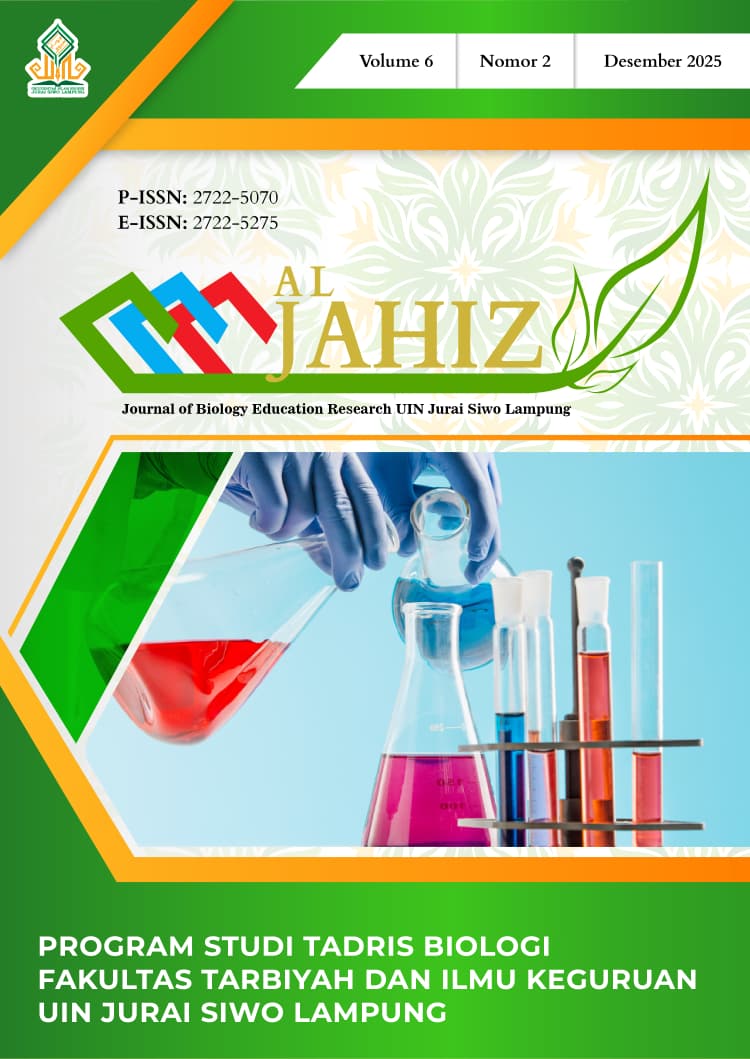Development of a Problem-Based Instruction Student Worksheet on Environmental Change to Improve Senior High School Students’ Scientific Literacy
DOI:
https://doi.org/10.32332/al-jahiz.v6i2.11159Keywords:
Student worksheet, Problem-based instruction, Science literacy, 21st century educationAbstract
This research aims to develop PBI-based student worksheet to improve science literacy and critical thinking of high school grade X students. The research method uses the Plomp Research and Development (R&D) model which consists of initial investigation, design, and evaluation stages. Formative evaluation refers to the Tessmer model, including self-evaluation, expert review, one-to-one, small group, and field test. The instruments used included validation sheets, response questionnaires, and science literacy ability tests. The subjects of the study were 29 students divided into experimental and control classes. The validation results showed that student worksheet was very valid (average score of 87.5%), practical (student and teacher response ≥85%), and effective in improving science literacy. The increase in science literacy gain score was 0.48 (experimental class) and 0.36 (control). The t-test showed significant differences between groups (p < 0.05). Thus, PBI-based student worksheet is suitable for use as a learning medium to improve students' 21st century skills.
References
(OECD), O. for E. C. and D. (2019). PISA 2018 Assessment and Analytical Framework: Mathematics, Reading, Science and Financial Literacy. OECD Publishing. https://doi.org/10.1787/b25efab8-en
Ain, Q., & Mitarlis, M. (2020). Pengembangan LKPD Berbasis Masalah untuk Meningkatkan Literasi Sains pada Materi Laju Reaksi. UNESA Journal of Chemical Education, 9(3), 397–406. https://doi.org/10.26740/ujced.v9n3.p397-406
Amaliyah, N., & Wasis. (2022). Problem Based Instruction dalam pembelajaran IPA untuk meningkatkan keterampilan berpikir kritis siswa. Jurnal Pendidikan IPA Indonesia, 11(1), 115–125. https://doi.org/10.15294/jpii.v11i1.31620
Kementerian Pendidikan Riset, dan Teknologi, K. (2022a). Capaian Pembelajaran Sekolah Menengah Atas (SMA) Fase E: Ilmu Pengetahuan Alam – Biologi. Direktorat Jenderal Pendidikan Anak Usia Dini, Pendidikan Dasar, dan Pendidikan Menengah. https://kurikulum.kemdikbud.go.id/
Kementerian Pendidikan Riset, dan Teknologi, K. (2022b). Panduan Pembelajaran dan Asesmen Kurikulum Merdeka. Kemendikbudristek. https://kurikulum.kemdikbud.go.id/
Ningsih, A., & Maknun, J. (2020). Analisis literasi sains siswa SMA dalam pembelajaran fisika. Jurnal Pendidikan Fisika Dan Keilmuan (JPFK), 6(1), 14–21. https://doi.org/10.25273/jpfk.v6i1.5912
Nurhayati, D., & al., et. (2024). Pembelajaran abad 21 dalam perspektif 4C. Jurnal Pendidikan Sains, 14(1), 55–66. https://doi.org/https://doi.org/10.22219/jps.v14i1.62351
OECD. (2019). PISA 2018 results (Volume I): What students know and can do. OECD Publishing. https://doi.org/10.1787/5f07c754-en
Öztürk, T., & Yıldırım, A. (2021). The Effects of Problem-Based Learning on Biology Students’ Conceptual Understanding and Critical Thinking. Journal of Biological Education, 55(4), 456–467. https://doi.org/10.1080/00219266.2020.1733948
Plomp, T., & Nieveen, N. (2013). Educational design research: Part A: An introduction. Netherlands Institute for Curriculum Development (SLO).
Puneeri, C. R., & Ramadhani, M. (2022). Development of student worksheets based on science literacy as supporting teaching materials for learning colloidal concepts. Educator Development Journal. https://ejournal.undiksha.ac.id/index.php/jpp/article/view/38263
Ramadhan, A., & Mardin, S. (2023). Problem-based learning: Improving critical thinking abilities, science literacy, and students’ independence in biology. International Journal of Science and Research Archive, 10(2), 772–779. https://www.researchgate.net/publication/376982919_Problem-based_learning_Improving_critical_thinking_abilities_science_literacy_and_students%27_independence_in_biology
Resi, P. W. M., & Sihotang, H. (2023). Literasi sains dalam meningkatkan kemampuan bernalar kritis dan kreatif sesuai dengan Profil Pelajar Pancasila pada SMA Negeri 02 Kabola. Syntax Literate: Jurnal Ilmiah Indonesia, 8(10), 1–12. https://www.jurnal.syntaxliterate.co.id/index.php/syntax-literate/article/view/12122
Sholahuddin, A., Normina, N., & Iriani, R. (2023). Improving students’ scientific literacy: Development of guided inquiry-based student worksheets on buffer solution material. Jurnal Pendidikan Kimia, 16(2). https://doi.org/10.24114/jpkim.v16i2.56718
Sihombing, A. D., Rangkuty, S. M., Novianti, C., Umayya, E. F., Zahra, M., Shalsabila, S., & Mecca, Z. A. (2024). Studi literatur: analisis kemampuan literasi sains peserta didik pada pembelajaran Biologi. Jurnal Pendidikan Inklusif, 8(12). https://jurnal.unsyiah.ac.id/pendidikaninklusif/article/view/28424
Suradi, S., Prastowo, S. B., & Sutomo, M. (2023). Development of PBL-based interactive LKPD to improve elementary students’ critical thinking skills in science learning. Jurnal Paedagogy, 10(2). https://doi.org/10.33394/jp.v10i2.10034
Wardani, S., Widodo, A. T., & Priyani, N. E. (2023). Peningkatan hasil belajar siswa melalui pendekatan keterampilan proses sains berorientasi Problem Based Instruction. Jurnal Inovasi Pendidikan Kimia, 3(1). https://doi.org/10.15294/jipk.v3i1.1271
Wijayanti, R., & Kurniawati, I. (2021). Efektivitas Problem Based Instruction dalam Meningkatkan Kemampuan Berpikir Ilmiah Peserta Didik. Jurnal Inovasi Pendidikan IPA, 7(2), 214–222. https://doi.org/10.21831/jipi.v7i2.38456
Zahra, A. D., Anggis, E. V., & Ismail, I. (2022). Pengembangan LKPD biologi berbasis PBL terintegrasi Unity of Sciences untuk melatih kemampuan literasi sains siswa kelas XI IPA SMA. Bioedukasi: Jurnal Pendidikan Biologi, 16(1), 1. https://doi.org/10.24127/bioedukasi.v16i1.11074
Downloads
Published
Issue
Section
License
Copyright (c) 2025 Threesia Anugrah Ilahi, Irdawati, Yuni Ahda, Fitri Arsih, Suci Fajrina

This work is licensed under a Creative Commons Attribution-ShareAlike 4.0 International License.


















